Research and scholarly material on flame and combustion.
TO
| Creator | Title | Date | Description | ||
|---|---|---|---|---|---|
| 1 |
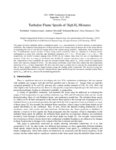 |
Venkateswaran, Prabhakar; Marshall, Andrew; Bahous, Edouard; Seitzman, J. Lieuwen, Tim | Turbulent flame speeds of high H2 mixtures | 2011 | This paper describes turbulent global consumption speed, ST,GC, measurements of H2/CO mixtures at atmospheric conditions. The turbulent flame properties of these mixtures are of strong practical interest due to the rising interest in expanding the role of coal-derived syngas fuels in the current ene... |
| 2 |
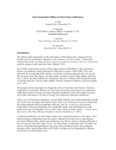 |
Pohl, John; Gogolek, Peter E.G.; Seebold, James G.; Schwartz, Robert | Fuel composition effect on flare flame inefficiency | 2004 | The effects of fuel composition on the performance of flare flames have long been known. Possibly the first performance indicator was the tendency of a fuel to smoke. Various fuel characteristics such as average molecular weight and carbon-to-hydrogen ratio were advanced to guide the design of early... |
| 3 |
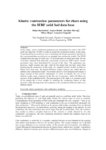 |
Karlstrom, Oskar; Brink, Anders; Hercog, Jaroslaw; Hupa, Mikko; Tognotti, Leonardo | Kinetic combustion parameters for chars using to IFRF solid fuel data base | 2009 | In this study, kinetic combustion parameters are determined for chars in the IFRF solid fuel data base (SFDB) in order to model the combustion history of the chars. Experimental burn-out data are used to determine the kinetic parameters that best fit the experimental data according to two standard c... |
| 4 |
 |
Smith, Philip J. | Clean and secure energy from domestic oil shale and oil sands resources: Quarterly progress report: July 2011 to September 2011 | 2011 | |
| 5 |
 |
Smith, Philip J. | Clean and secure energy from domestic oil shale and oil sands resources: Quarterly progress report: January 1, 2010 to March 31, 2010 | 2010 | The Clean and Secure Energy from Domestic Oil Shale and Oil Sands Resources program is part of the research agenda of the Institute for Clean and Secure Energy (ICSE) at the University of Utah. In this quarter, the Clean and Secure Energy program continued its focus on enhancing industrial, national... |
| 6 |
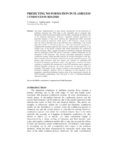 |
Parente, A.; Galletti, C.; Tognotti, Leonardo | Predicting no formation in flameless combustion regime | 2009 | The direct implementation of large kinetic mechanisms for the prediction of pollutant emissions into CFD codes is still unfeasible, due to computer time limitations which become particularly relevant when considering the typical scale of the industrial applications. Therefore, simplified modeling ap... |
| 7 |
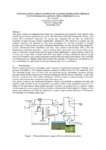 |
Jansohn, Peter | Investigations_about_Co_firing_of_gasified_herbaceous_biomass_in_an_integrated_gasification_combined_cycle | This paper focuses on combustion tests which were conducted to investigate the flame stability when product gas of biomass gasification is mixed with natural gas (NG) and subsequently burned in gas turbine (GT) combustors. Especially the product gas component H2 can alter the combustion properties o... | |
| 8 |
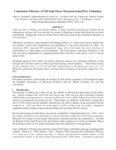 |
Chambers, Allan K.; Wootton, Tony; Moncrieff, Jan; McCready, Philip | Combustion efficiency of full scale flares measured using DIAL technology | 2004 | Flares are used in Alberta's oil and gas industry to safely treat H2S containing gas releases during emergencies, and gas well flow tests and as a means of disposing of gases that cannot be recovered economically. Despite the wide use of these flares, little data exists on the combustion efficiency ... |
| 9 |
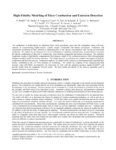 |
Panfili, R.; Dothe, H.; Vujkovic-Cvijin, P.; Tan, X.; Kennett, R.; Taylor, R.; Bernstein, L.; Smith, Philip J.; Thornock, J.N.; Gross, K.; Seebold, J. G. | High fidelity modeling of flare combustion and emission detection | 2011-08-17 | The combustion of hydrocarbons by industrial flares emits greenhouse gases into the atmosphere along with trace amounts of ozone-forming highly-reactive volatile organic compounds and human carcinogens. Continuous and autonomous monitoring of flare emission is challenging due to low species concentr... |
| 10 |
 |
Zhan, Z. | Effects of Coal Blends on Formation Mechanisms of Ash Aerosol and Ash Deposits during Air and Oxy-Combustion | 2015-09-11 | Paper from the AFRC 2015 conference titled Effects of Coal Blends on Formation Mechanisms of Ash Aerosol and Ash Deposits during Air and Oxy-Combustion |
| 11 |
 |
Zhang, Jingwei; Kelly, Kerry; Eddings, Eric G.; Wendt, Jost O. L. | Oxy-coal combustion: effects of PO2 on coal jet stability in 02/C02 environnments | 2009 | The purpose of this research is to understand and predict the effects of near burner zone environment on ignition characteristics of a turbulent axial pulverized coal jet. In oxy-coal combustion this environment consists of O2 and CO2 (instead of N2). Ultimately the experiment will provide data for ... |
| 12 |
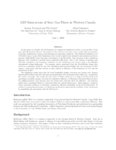 |
Thornock, Jeremy; Smith, Philip; Chambers, Allan K. | LES simulations of sour gas flares in Western Canada | 2009 | In this paper we describe the development of a numerical simulation tool for a sour gas flare of the type typically found in Alberta. The purpose of the model is to provide a way to guide safer sour gas flare operating conditions for varying environmental and operating conditions. The numerical simu... |
| 13 |
 |
Seebold, James G.; Davis, Bruce; Gogolek, Peter E.G.; Kostiuk, Larry; Pohl, John; Schwartz, Robert; Soelberg, Nick; Strosher, Mel; Walsh, Pete | Reaction efficiency of industrial flares the perspective of the past | 2003 | Dahm, Werner J. A. (2007). Scaling relations for flare interactions, flame lengths, and crosslighting requirements in large flare. American Flame Research Committee (AFRC). |
| 14 |
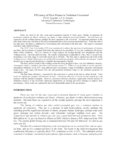 |
Gogolek, Peter E.G.; Hayden, A.C.S. | Efficiency of flare flames in turbulent crosswind | 2010 | Flares are used for the safe, clean and economical disposal of waste gases, whether in upstream oil production (solution gas flares), refineries, gas plants or other chemical processing facilities. Elevated flares are exposed to all the weather patterns, perhaps the most important is the crosswind. ... |
| 15 |
 |
Smith, Philip J. | Clean and secure energy from domestic oil shale and oil sands resources: Quarterly progress report: July 2010 to September 2010 | 2010 | The Clean and Secure Energy from Domestic Oil Shale and Oil Sands Resources program is part of the research agenda of the Institute for Clean and Secure Energy (ICSE) at the University of Utah. In this quarter, the Clean and Secure Energy program was involved in multiple technology transfer and outr... |
| 16 |
 |
Payne, R.; Akiyama, T.; Witkamp, J.; Delft, J. | Studies on the pollutant emission characteristics of a number of oil-fired industrial process burners and the relationship to firing conditions | 1980 | |
| 17 |
 |
Martin, Matthew | Comparison of empirically based calculation methods for pipe flares to computational fluid dynamics | 2007 | As available computational resources increase and the use of computational fluid dynamics (CFD) becomes more widely accepted wider classes of industrial scale combustion systems are being simulated and optimized using these resources. A largebody of empirically based work has already been assembled ... |
| 18 |
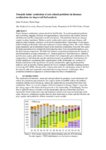 |
Werkelin, Johan; Hupa, Mikko | Towards better prediction of ash related problems in biomass combustion via improved fuel analysis | 2009 | Future biomass combustion systems should be fuel flexible. To avoid operational problems such as fouling, slagging, fluidized bed agglomeration, and corrosion, the relation between ash behaviour and fuel composition needs to be known. Ash-related problems are strongly coupled to phase transitions. M... |
| 19 |
 |
Pagot, P. R.; Grandmaison, E. W.; Sobiesiak, A. | Some characteristics of multi-jet flares | 2004 | Results of a test program with a multi-jet, high momentum burner simulating many of the features found in offshore flare systems are described. Previous work (Pagot et al., 2003) has given background on a hot and cold model study for this type of flare. The features of the flare flames are described... |
| 20 |
 |
Zeuthen, Jacob Hjerrild; Pedersen, Anne Juul; Riber, Christian; Astrup, Thomas; Hansen, Jorn; Frandsen, Flemming Jappe; Livbjerg, Hans | Combustion aerosols from municipal waste incineration - effects of feedstock composition and boiler operation | 2009 | Combustion aerosols were measured in the 22 MWth FASAN Waste-to-Energy (WtE) boiler while applying changes in feedstock composition and grate operation conditions, respectively. The changes in feedstock composition were applied by adding (one-by-one) dedicated waste fractions, comprising PVC plastic... |
| 21 |
 |
Martin, Richard; Nickeson, Dale | Low Nox Burner Development for High Temperature Reforming and Cracking Furnaces | ||
| 22 |
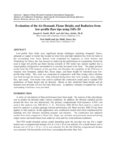 |
Smith, Joseph D.; Suo-Anttila, Ahti; Smith, Scot K.; Modi, Jay B. | Evaluation of the air-demand, flame height, and radiation from low-profile flare tips using ISIS-3D | 2007 | Low-profile flare fields pose significant design challenges including elongated flames, adequate air supply to burner tips located on inner rows and high radiation flux from the flame to the surrounding wind fence. Recent work completed by engineers at Alion Science and Technology for Zeeco, Inc. ha... |
| 23 |
 |
Dahm, Werner J.A. | Scaling relations for flare interactions, flame lengths, and crosslighting requirements in large flare fields | 2007 | Flare fields typically consist of many closely-spaced flares arranged in parallel rows. Each flare in the field produces an axisymmetric buoyant jet flame that for a limited vertical distance develops essentially independent of the other flames in the field. However, at a distance above the flare ti... |
| 24 |
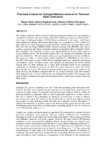 |
Shelil, Nasser; Bagdanavicius, Audrius; Griffiths, Anthony; Syred, Nick | Flashback analysis for hydrogen/methane mixtures for premixed swirl combustion | 2009 | The flashback problem which occurs by using lean premixed combustion in gas turbines is considered. Flashback simulation studies using CFD modelling package are performed for a wide range of hydrogen/methane (H2/CH4) blends combusted by air using a swirl burner under premixed conditions. The laminar... |
| 25 |
 |
Shore, David | Improving flare design a transition from art-form to engineering science | 2007 | Many of the day-to-day activities surrounding Flaring, at both the project design and operational stages, are vague and apparently outside the control of the Flare Engineer. Design specifications usually only cover a single case out of a multitude of possible compositions and flows. In service, flow... |
